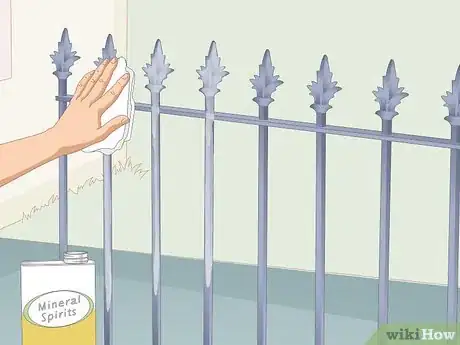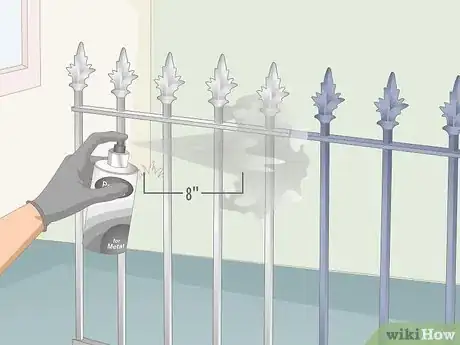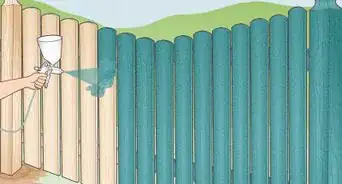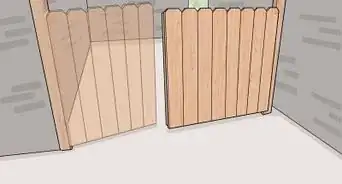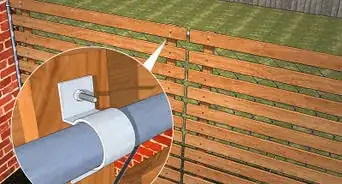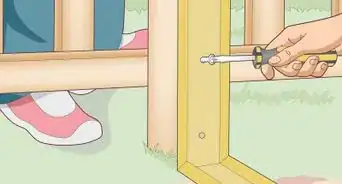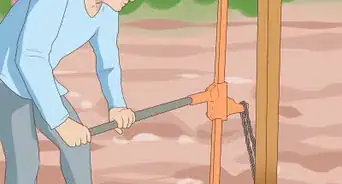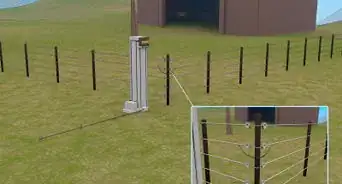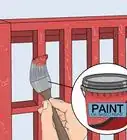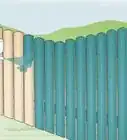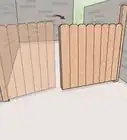This article was co-authored by Andres Matheu. Andres Matheu is the Owner of Hömm Certified Painting Systems, an Interior and Exterior Residential painting business based in the Washington, DC Metro area. Andres specializes in interior and exterior residential painting, color consultations, cabinet refinishing, wallpaper removal, and epoxy flooring among other services. An EPA Lead-safe Certified Firm, Hömm Certified Painting Systems has been awarded the Best of Houzz 2019 Service, Angie's List Super Service Award 2019, and Northern Virginia Magazine's 2018 Best Home Experts (painters) award.
There are 9 references cited in this article, which can be found at the bottom of the page.
wikiHow marks an article as reader-approved once it receives enough positive feedback. In this case, 100% of readers who voted found the article helpful, earning it our reader-approved status.
This article has been viewed 195,294 times.
Decorative wrought iron fences are beautiful and sturdy, and can add an air of elegance to your home or garden. However, constant exposure to the elements can do quite a bit of damage to the iron surface. Applying a fresh coat of paint will keep your fence in great shape. In order to successfully paint a wrought iron fence, you will need to properly prepare the metal surface and surrounding area. Start by scraping off any remaining rust and paint, then giving the fence a good sanding. Use an oil-based primer and apply an even coat over the whole fence. After the primer dries, your fence is ready for painting.
Steps
Removing Paint and Rust
-
1Spread a sheet or drop cloth around the fence. Removing all the paint and rust from a fence is a dirty job. Keep your property clean by laying out a sheet or drop cloth to catch falling debris. Cover your grass, porch, sidewalk, and any other areas that might get dirty during the job.[1]
- Try to avoid doing this job in windy weather to reduce the mess.
- Scraping, sanding, and priming is a long process. Start early in the morning and plan on working all day. The process may take into a second day, depending on how large the fence is.
-
2Put on gloves, a dust mask, and goggles. Paint and rust shards can irritate your skin, throat, and eyes. Protect yourself with the proper equipment before starting. Cover your eyes with goggles and put on a dust mask. Wear gloves to prevent cuts and irritation.[2]
- Also cover all of your exposed skin with long sleeves and pants to prevent irritations from paint shards.
- All the necessary protective gear is available at hardware stores or online. If you order from the internet, make sure you can return the items if they don't fit.
Advertisement -
3Scrape flat surfaces with a metal scraper to remove paint and rust. Any leftover paint or rust on the iron will prevent a new coat of paint from sticking properly. Take a metal scraper and rub all the flat sections of the fence. Scrape back and forth until the paint and rust comes off.[3]
- Don’t miss any spots. Scrub all the spots you can reach with the scraper before moving on.
- This step only removes flaking rust and metal, it doesn’t smooth out the iron surface. Don’t worry if the iron is still rough after scraping it.
- You can also use a power washer to remove any loose rust or dirt.[4]
-
4Rub curved areas with a wire brush. Many fences have designs and a flat metal scraper won’t be able to reach into rounded or curved areas like these. Take a wire brush and scrub all the areas you couldn’t reach with the scraper. Rub back and forth to flake off any paint and rust.[5]
- Don’t miss any spots. Any paint or rust you leave behind will damage your new coat of paint. Be thorough and reach every spot with the brush.
- If there are still tough rust spots that won’t come off, try using a powered grinder to remove them. This uses a spinning stone to grind away rust. Wear gloves and goggles if you use this tool, and hold it against any rusty spots until they're smooth. You can buy or rent a powered grinder from a hardware store.
-
5Sand the fence with 150-grit sandpaper. Sanding smooths the iron out in preparation for a fresh coat of paint.[6] Use a 150-grit paper or sanding sponge and sand the whole surface. Use a steady, back and forth motion to grind down and rough spots.[7]
- Remember to get into any grooves and curved areas. Don’t miss any spots.
- Don’t remove your protective gear when you sand. The dust can still irritate your eyes and skin.
- Sanding is a time-consuming process. Be patient and don’t rush.
-
6Rub the fence with mineral spirits to remove any remaining dust. Pour mineral spirits into a rag and rub it over the whole fence. Don’t worry about scrubbing hard. The rag should pick up any residue. Re-wet the rag if you have to, especially if you’re working on a large piece of iron.[8]
- Mineral spirits are a relatively safe solvent, but they can still irritate your skin. Wear gloves and if you get any on your skin, flush the area under running water for 5 minutes.[9]
- Mineral spirits are available at most hardware stores.
- Don’t clean the iron with water. This will cause rust.
Priming the Metal
-
1Use an oil-based primer designed for iron surfaces. Don’t let the fence sit long after you sand the paint off. Apply primer as soon as possible to prevent rusting. Oil-based primers and paints are best for outdoor metal surfaces. They adhere much better to metal and resist the elements well. Look for a specialized metal primer at the hardware store. You can choose between a roll-on and spray primer.[10]
- A roll-on primer is applied with a brush or roller like paint. This is more time-consuming, but it’s easier to control and avoids making a mess.
- Spray primer works the same way as spray paint and is faster to work with. Make sure you cover everything in the area with a sheet to avoid getting primer on it and don’t work if it’s windy.
- Ask a hardware store employee for help if you can’t find primers designed for metal.
-
2Roll an even coat of primer onto the fence. If you’re using roll-on primer, pour some into a paint tray. Then dip a paint roller in and wet it with primer. Use smooth strokes and apply the primer onto the fence. Work carefully and make sure you get between all the railings. If you leave any spots bare, the paint won't adhere properly.[11]
- Roll back and forth a few times to make sure each spot is covered with primer.
- Don’t miss any spots. Touch up areas the roller won’t fit into with a brush.
-
3Spray the primer 8 inches (20 cm) from the fence’s surface. Spray primer works the same way as spray paint. Shake the can well before spraying. Then hold the can about 8 inches (20 cm) from the metal and spray in a back and forth motion. Keep the can moving. Spray the entire fence with an even layer of primer.[12]
- Don’t hover the can in one spot or the primer could pool and drip.
- Wear goggles and a dust mask while using spray primer.
- Place extra sheets around to prevent primer from getting on your grass, porch, or house. Stop working if the wind picks up.
- If you feel dizzy or faint while spraying the primer, stop right away.
-
4Let the primer dry for 2-4 hours before painting. The exact drying time depends on the weather and what type of primer you used. Spray primer dries faster and should be ready in about 2 hours. Roll-on primer takes closer to 4 hours. Both take longer if the weather is humid.[13]
- Tap the fence gently with your finger to monitor how dry the primer is. If it still feels sticky, it’s not dry enough.
- Start painting once the primer is dry for the best coat of paint.
Expert Q&A
Did you know you can get expert answers for this article?
Unlock expert answers by supporting wikiHow
-
QuestionHow do I prepare a fence for painting?
 Andres MatheuAndres Matheu is the Owner of Hömm Certified Painting Systems, an Interior and Exterior Residential painting business based in the Washington, DC Metro area. Andres specializes in interior and exterior residential painting, color consultations, cabinet refinishing, wallpaper removal, and epoxy flooring among other services. An EPA Lead-safe Certified Firm, Hömm Certified Painting Systems has been awarded the Best of Houzz 2019 Service, Angie's List Super Service Award 2019, and Northern Virginia Magazine's 2018 Best Home Experts (painters) award.
Andres MatheuAndres Matheu is the Owner of Hömm Certified Painting Systems, an Interior and Exterior Residential painting business based in the Washington, DC Metro area. Andres specializes in interior and exterior residential painting, color consultations, cabinet refinishing, wallpaper removal, and epoxy flooring among other services. An EPA Lead-safe Certified Firm, Hömm Certified Painting Systems has been awarded the Best of Houzz 2019 Service, Angie's List Super Service Award 2019, and Northern Virginia Magazine's 2018 Best Home Experts (painters) award.
Commercial Painter
-
QuestionIs it true I should avoid painting an iron gate in temperatures over 95F?
 Community AnswerPainting pretty much anything at that temperature is ill-advised. All paints and stains have instructions on the can that tell the best temperatures and humidity levels for painting/staining. In temperauress as high as 95 or above, the paint is drying too fast to keep a wet edge, making brush marks more visible. It is also not a safe temperature for laboring outside for too long.
Community AnswerPainting pretty much anything at that temperature is ill-advised. All paints and stains have instructions on the can that tell the best temperatures and humidity levels for painting/staining. In temperauress as high as 95 or above, the paint is drying too fast to keep a wet edge, making brush marks more visible. It is also not a safe temperature for laboring outside for too long. -
QuestionWhat are the consequences if I don't apply a rust inhibitor?
 Community AnswerThe rust inhibitor is the key to making sure the paint layer is strong so you don't have to repaint often. Skipping this step would mean you need to paint the fence again sooner.
Community AnswerThe rust inhibitor is the key to making sure the paint layer is strong so you don't have to repaint often. Skipping this step would mean you need to paint the fence again sooner.
Things You'll Need
Removing Paint and Rust
- Wire brush
- Metal scraper
- Rag
- Sandpaper
- Drop cloth
Priming the Metal
- Spray or roll-on primer
- Paintbrush
- Paint roller
References
- ↑ https://www.cpsc.gov/s3fs-public/painting.pdf
- ↑ https://www.bobvila.com/articles/how-to-remove-paint-from-metal/
- ↑ https://youtu.be/8JxHFDUtSHI?t=105
- ↑ Andres Matheu. Commercial Painter. Expert Interview. 28 July 2020.
- ↑ https://www.thisoldhouse.com/ask-toh/repainting-metal-railings
- ↑ Andres Matheu. Commercial Painter. Expert Interview. 28 July 2020.
- ↑ https://youtu.be/8JxHFDUtSHI?t=146
- ↑ https://www.bobvila.com/articles/how-to-remove-paint-from-metal/
- ↑ https://professionalartistmag.com/using-solvents/






